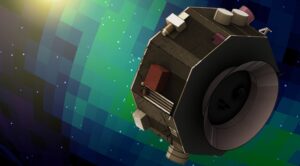New NASA office coordinates rideshare launches of smallsat science missions
By Jeff Foust

WASHINGTON — NASA has established an office to coordinate rideshare launch opportunities for its growing number of smallsat science missions, taking advantage of excess capacity on launches of larger spacecraft.
NASA’s Science Mission Directorate (SMD) established the rideshare office earlier this year as part of broader efforts to promote the use of cubesats and other smallsats to carry out a wide range of missions.
“The goal of the rideshare office is to provide a single point of contact for all SMD rideshare-related inquiries,” said Aly Mendoza-Hill, head of the office, at a NASA town hall meeting Aug. 3 during the Conference on Small Satellites. “We help everybody out with implementing rideshare on SMD launches.”
Thomas Zurbuchen, NASA associate administrator for science, announced in a keynote at the conference two years ago that NASA would fly payload adapters for secondary payloads on all launches of science missions that had excess capacity. “We’re not going to ask whether we need it,” he said in that speech. “You have to convince us that we don’t need it.”
SMD adopted a formal policy for doing so last October, Mendoza-Hill said. That policy states that, for science missions whose launches have excess capacity, the directorate will use that capacity for SMD-sponsored secondary payloads, or offer it to other NASA directorates or other U.S. government agencies.
The office is located in NASA’s heliophysics division but supports all of NASA’s science divisions. “We want to create a unified NASA SMD rideshare message to everyone,” she said, including analyzing what missions are compatible with specific opportunities.
One example is NASA’s Interstellar Mapping and Acceleration Probe (IMAP) spacecraft, which the agency identified as a likely candidate to host rideshare payloads two years ago. IMAP will carry the Lunar Trailblazer planetary science smallsat and NOAA’s Space Weather Follow-On spacecraft as secondary payloads, along with potential science and technology missions of opportunity for heliophysics, when it launches in October 2024.
NASA’s Psyche mission to the asteroid of the same name, scheduled for launch on a Falcon Heavy in the summer of 2022, will also host secondary payloads. They include Janus, a smallsat mission to study binary asteroids, and EscaPADE, a smallsat to study the Martian atmosphere.
Mendoza-Hill said most of the secondary payload opportunities on SMD missions through 2024 are already filled, with the exception of the SPHEREx astrophysics mission launching in 2024. The office is tracking potential rideshare opportunities later in the decade on science missions, including the Dragonfly mission to Saturn’s moon Titan, although how much excess launch capacity those missions will have isn’t known yet.
The rideshare office does not deal with cubesat missions. Those are handled by NASA’s CubeSat Launch Initiative (CSLI), which coordinates cubesat launches for NASA centers and universities. CSLI passed the milestone of 100 cubesats launched earlier this year with the deployment of a set of cubesats from the International Space Station.
Scott Higginbotham, who leads the CSLI effort for NASA’s Launch Services Program, said at the town hall meeting that it has 51 missions manifested for launch through next year. However, the program has been struggling with delays because of the pandemic.
“We have been dramatically impacted by the pandemic,” he said, such as universities that closed in the spring, halting work on cubesats being completed for launch through CSLI. “We’re in a recovery mode right now.”
In March, CLSI had 31 cubesats scheduled to launch through the rest of the year, Higginbotham said. So far, just one of them has launched, the ANDESITE cubesat from Boston University, which flew on a Rocket Lab Electron launch in June. At last 15 of the remaining 30 have been delayed to 2021.
August 4, 2020 at 08:16PM
via SpaceNews read more...

Post a Comment